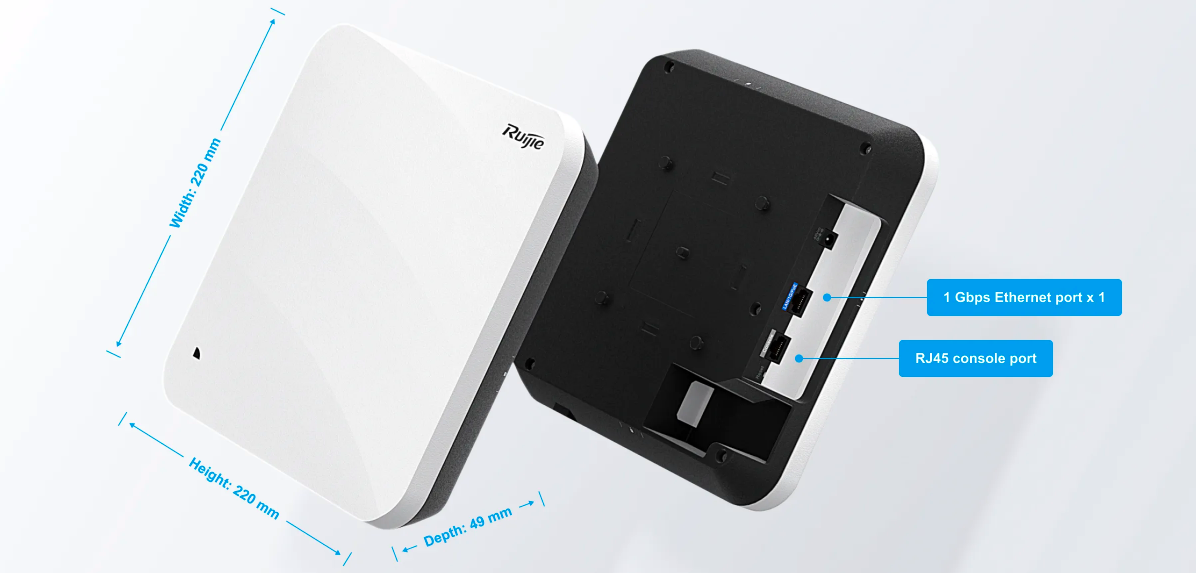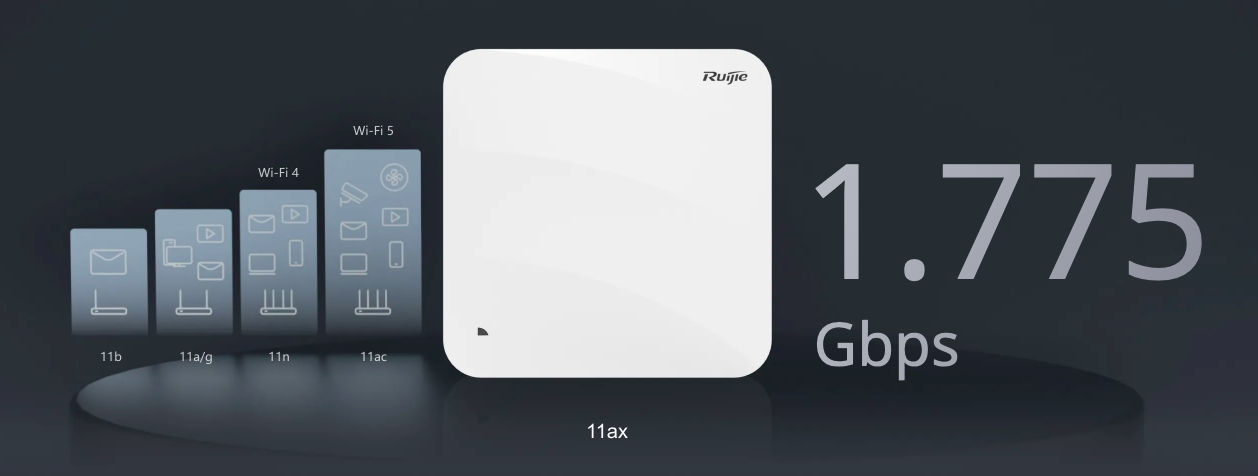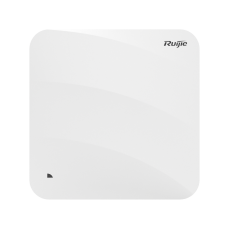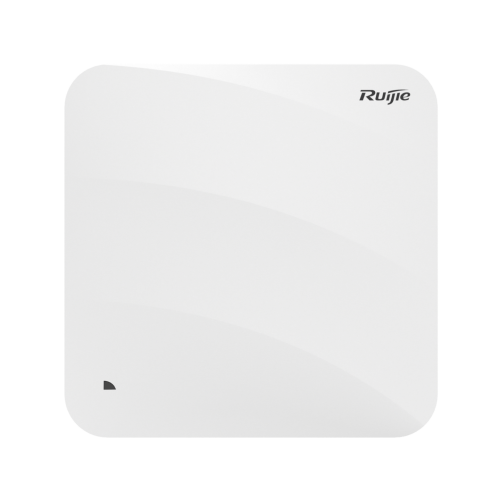RG-AP810-L, Wi-Fi 6 Dual-Radio 1.775 Gbps Indoor Access Point Best Price In Dubai, UAE.
Availability:
In Stock
Recommended for indoor scenarios covering hotels, businesses, and governments
Highlight Features
- Next-gen Wi-Fi 6 technology, high concurrency, ultra-fast speed
- Intelligent roaming with 802.11k/v/r protocols, smooth roaming experience
- PoE and DC power supply, flexible deployment
- Ruijie cloud management, intelligent optimization
Description
Key Specification
Building a High-Speed and Efficient Network with Wi-Fi 6
Indoor Access Point RG-AP810-L






1.775 Gbps High Speed with Wi-Fi 6

High speed:
1024QAM modulation, 25% higher data transfer rate than 802.11ac
High concurrency:
OFDMA and MU-MIMO transfer technologies, 4x more concurrent users than Wi-Fi 5
High Security
The next-generation wireless encryption protocol WPA3 greatly improves the security of wireless connection.
Low latency:
OFDMA technology reduces the delay to as low as 20 ms, improving UX in video and audio services
Specifications
| Dimensions and Weight |
RG-AP810-L |
| Unit dimensions (W x D x H) |
220 mm x 220 mm x 49 mm (8.7 in x 8.7 in x 2.0 in) |
| Shipping dimensions (W x D x H) |
507 mm x 319 mm x 278 mm (20.0 in x 12.6 in x 11.0 in) |
| Unit weight |
Device: 0.6 kg (1.33 lbs) Mounting bracket: 0.07 kg (0.15 lbs) |
| Shipping weight |
1.04 kg (2.29 lbs) |
| Mounting |
Wall/Ceiling-mount (A mounting bracket is delivered with the main unit) |
| Lock option |
Kensington lock and securing latch |
| Wi-Fi Radio |
RG-AP810-L |
| Radio design |
Dual-radio Radio 1: 2.4 GHz, two spatial streams, 2x2 MU-MIMO Radio 2: 5 GHz, two spatial streams, 2x2 MU-MIMO |
| Operating frequencies |
Radio 1, 802.11b/g/n/ax: ● 2.400 GHz to 2.4835 GHz, ISM Radio 2, 802.11a/n/ac/ax: ● 5.150 GHz to 5.250 GHz, U-NII-1 ● 5.250 GHz to 5.350 GHz, U-NII-2A ● 5.470 GHz to 5.725 GHz, U-NII-2C ● 5.725 GHz to 5.850 GHz, U-NII-3/ISM Note: Country-specific restrictions apply. |
| Data rates |
Combined peak data rate: 1.775 Gbps 2.4 GHz radio, 574 Mbps ● Two spatial stream Single User (SU) MIMO for up to 574 Mbps wireless data rate to individual 2SS HE40 802.11ax client devices (max.) ● Two spatial stream Single User (SU) MIMO for up to 287 Mbps wireless data rate to individual 2SS HE20 802.11ax client devices (typical) 5 GHz radio, 1.201 Gbps ● Two spatial stream Single User (SU) MIMO for up to 1.201 Gbps wireless data rate to 2SS HE80 802.11ax client devices (typical) |
| Data rate set |
The following 802.11-compliant data rates in Mbps are supported: 2.4 GHz radio ● 802.11b: 1, 2, 5.5, 11 ● 802.11g: 1, 2, 5.5, 6, 9, 11, 12, 18, 24 ,36, 48, 54 ● 802.11n: 6.5 to 300 (MCS0 to MCS15, HT20 to HT40) ● 802.11ax: 8.6 to 574 (MCS0 to MCS11, NSS = 1 to 2, HE20 to HE40) 5 GHz radio ● 802.11a: 6, 9, 12, 18, 24, 36, 48, 54 ● 802.11n: 6.5 to 300 (MCS0 to MCS15, HT20 to HT40) ● 802.11ac: 6.5 to 867 (MCS0 to MCS9, NSS = 1 to 4, VHT20 to VHT80) ● 802.11ax: 8.6 to 1,200 (MCS0 to MCS11, NSS = 1 to 2, HE20 to HE80) |
| Packet aggregation |
802.11n/ac/ax: A-MPDU and A-MSDU |
| Antenna type |
Built-in omnidirectional antennas (two 2.4 GHz antennas and two 5 GHz antennas) |
| Max. antenna gain |
2.8 dBi in 2.4 GHz and 3.6 dBi in 5 GHz The downtilt angle for the maximum gain is roughly 30 degrees. With reference to the pattern of each antenna of the MIMO radios, the maximum gain of the effective per-antenna pattern is 2.3 dBi in 2.4 GHz and 2.7 dBi in 5 GHz. |
| Max. transmit power |
2.4 GHz radio: 26 dBm (23 dBm per chain) 5 GHz radio: 26 dBm (23 dBm per chain) Note: The transmit power is limited by local regulatory requirements. |
| Power increment |
Configurable based on requirement |
| Radio technologies |
802.11b: Direct-Sequence Spread-Spectrum (DSSS) 802.11a/g/n/ac: Orthogonal Frequency-Division Multiplexing (OFDM) 802.11ax: Orthogonal Frequency Division Multiple Access (OFDMA) |
| Modulation types |
802.11b: BPSK, QPSK, CCK 802.11a/g/n: BPSK, QPSK, 16-QAM, 64-QAM 802.11ac: BPSK, QPSK, 16-QAM, 64-QAM, 256-QAM 802.11ax: BPSK, QPSK, 16-QAM, 64-QAM, 256-QAM, 1024-QAM |
The following table lists the radio frequency performance of Wi-Fi including different frequency bands, protocols, and date rates. It is country-specific, and Ruijie Networks reserves the right of interpretation.
| Wi-Fi Radio Frequency Performance |
RG-AP810-L |
||
| Frequency Band and Protocol |
Data Rate |
Max. Transmit Power per Transmit Chain |
Max. Receive Sensitivity per Receive Chain |
| 2.4 GHz, 802.11b |
1 Mbps |
23 dBm |
–91 dBm |
| 2 Mbps |
23 dBm |
–91 dBm |
|
| 5.5 Mbps |
23 dBm |
–90 dBm |
|
| 11 Mbps |
23 dBm |
–87 dBm |
|
| 2.4 GHz, 802.11g |
6 Mbps |
23 dBm |
–89 dBm |
| 24 Mbps |
22 dBm |
–82 dBm |
|
| 36 Mbps |
22 dBm |
–78 dBm |
|
| 54 Mbps |
20 dBm |
–72 dBm |
|
| 2.4 GHz, 802.11n (HT20) |
MCS0 |
23 dBm |
–85 dBm |
| MCS7 |
19 dBm |
–67 dBm |
|
| 2.4 GHz, 802.11n (HT40) |
MCS0 |
23 dBm |
–82 dBm |
| MCS7 |
19 dBm |
–64 dBm |
|
| 2.4 GHz, 802.11ax (HE20) |
MCS0 |
23 dBm |
–85 dBm |
| MCS11 |
15 dBm |
–58 dBm |
|
| 2.4 GHz, 802.11ax (HE40) |
MCS0 |
23 dBm |
–82 dBm |
| MCS11 |
15 dBm |
–54 dBm |
|
| 5 GHz, 802.11a |
6 Mbps |
23 dBm |
–89 dBm |
| 24 Mbps |
22 dBm |
–82 dBm |
|
| 36 Mbps |
22 dBm |
–78 dBm |
|
| 54 Mbps |
20 dBm |
–72 dBm |
|
| 5 GHz, 802.11n (HT20) |
MCS0 |
23 dBm |
–85 dBm |
| MCS7 |
19 dBm |
–67 dBm |
|
| 5 GHz, 802.11n (HT40) |
MCS0 |
23 dBm |
–82 dBm |
| MCS7 |
19 dBm |
–64 dBm |
|
| 5 GHz, 802.11ac (VHT20) |
MCS0 |
23 dBm |
–85 dBm |
| MCS9 |
18 dBm |
–60 dBm |
|
| 5 GHz, 802.11ac (VHT40) |
MCS0 |
23 dBm |
–82 dBm |
| MCS9 |
18 dBm |
–57 dBm |
|
| 5 GHz, 802.11ac (VHT80) |
MCS0 |
23 dBm |
–79 dBm |
| MCS9 |
18 dBm |
–53 dBm |
|
| 5 GHz, 802.11ax (HE20) |
MCS0 |
23 dBm |
–85 dBm |
| MCS11 |
16 dBm |
–58 dBm |
|
| 5 GHz, 802.11ax (HE40) |
MCS0 |
23 dBm |
–82 dBm |
| MCS11 |
16 dBm |
–54 dBm |
|
| 5 GHz, 802.11ax (HE80) |
MCS0 |
23 dBm |
–79 dBm |
| MCS11 |
16 dBm |
–52 dBm |
|






Reviews (0)